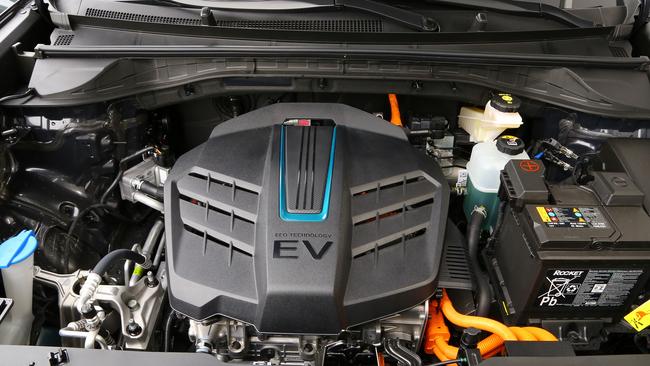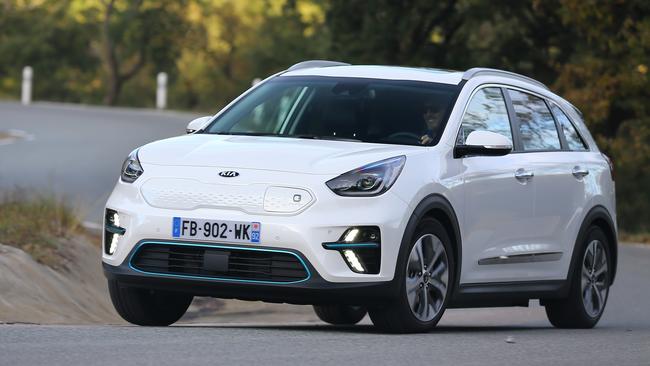Why Kia’s new e-Niro electric car is off-limits in Australia
Australia is at the back of the queue for this ground-breaking new SUV. And the company blames the government for the situation.
Hitech
Don't miss out on the headlines from Hitech. Followed categories will be added to My News.
This is the car Australia isn’t ready for. Kia initially planned to launch the new Kia e-Niro electric SUV at the Australian Open tennis in January but the launch has been put on hold, partly because our local emissions regulations don’t favour EVs.
Kia is installing EV charging points in dealerships and training staff in maintaining battery-powered vehicles but Australia has slipped well down Kia’s global pecking order for supply of the SUV. Put simply, the e-Niros that could have come here are being sent to more EV-friendly nations.
Kia Australia spokesman Kevin Hepworth says e-Niro has been put on hold because there are “no punitive government fines for not having electric vehicles”.
That’s in direct contrast with Europe.
Kia Europe design boss Gregory Guillaume says strict CO2 emissions regulations in Europe mean the brand’s fate in Europe is married to electric models.

Targets in place from 2021 mean the brand will only be able to sell about seven combustion-powered vehicles such as the Sportage SUV for every electric car it delivers.
“We can’t sell normal cars any more,” Guillaume says. “We have no choice”.
That is not the case in Australia, where manufacturers have no formal obligation to reduce emissions.
As with the Nissan Leaf and Hyundai Kona Electric, the e-Niro would cost about twice as much as conventionally powered counterparts.
European buyers have two e-Niro versions to choose from. The premium grade has a 150kW electric motor and 64kWh battery pack, against the 100kW and 39.2 kWh of the more affordable grade.

The bigger battery endows 455km range, according to the new European standard.
We tested the more powerful e-Niro in Germany, starting with a full charge, covering 199.7km and parking the vehicle with 229km of remaining range.
The test loop included urban running, country roads and autobahn stretches — where the car cruised at its 180km/h speed limit, making the real-world battery performance all the more impressive.
It’s much more convincing than entry-level electric cars now on sale in Australia. It’s also a multiple award winner in Europe. The question mark, as with all EVs, is the price tag.
Kia’s claimed 7.8 seconds for the 0-100km/h sprint feels conservative — the e-Niro picks up pace with ease thanks to peak torque of 395Nm.
It’s effortless to drive, and more engaging than most electric cars thanks to steering wheel-mounted paddles that allow the driver to set a preferred level of battery regeneration when lifting off the throttle.

The left paddle can also be used as a brake. Holding it down results in maximum regeneration until it comes to a stop.
The paddle may be an intriguing alternative to the conventional brake pedal but it can’t be modulated — it’s either on or off, which can make for jerky progress.
The Kia’s low centre of gravity and quick steering make for an endearing ride on twisty roads. Its powerful motor will spin the front wheels if you get heavy with the throttle at low speed.
Comprehensive driver aids add to its appeal, particularly when traffic jams allow you to use its mild autonomous driving features, which are similar to those on European luxury models.
Beyond that, it’s just like any other medium SUV. There’s ample room front and back, cargo space is generous and the seven-inch central display has such handy features as satnav and smartphone mirroring.

In Germany, the e-Niro sells for 35,290 euros ($56,500) or about 1500 euros ($2400) cheaper than the Leaf — which in Australia is about $54,500 drive-away.
Kia placed immense importance on the e-Niro, making it as attractive as possible to European drivers. But Australian customers will have to wait and see whether this impressive vehicle reaches local showrooms.
Originally published as Why Kia’s new e-Niro electric car is off-limits in Australia



